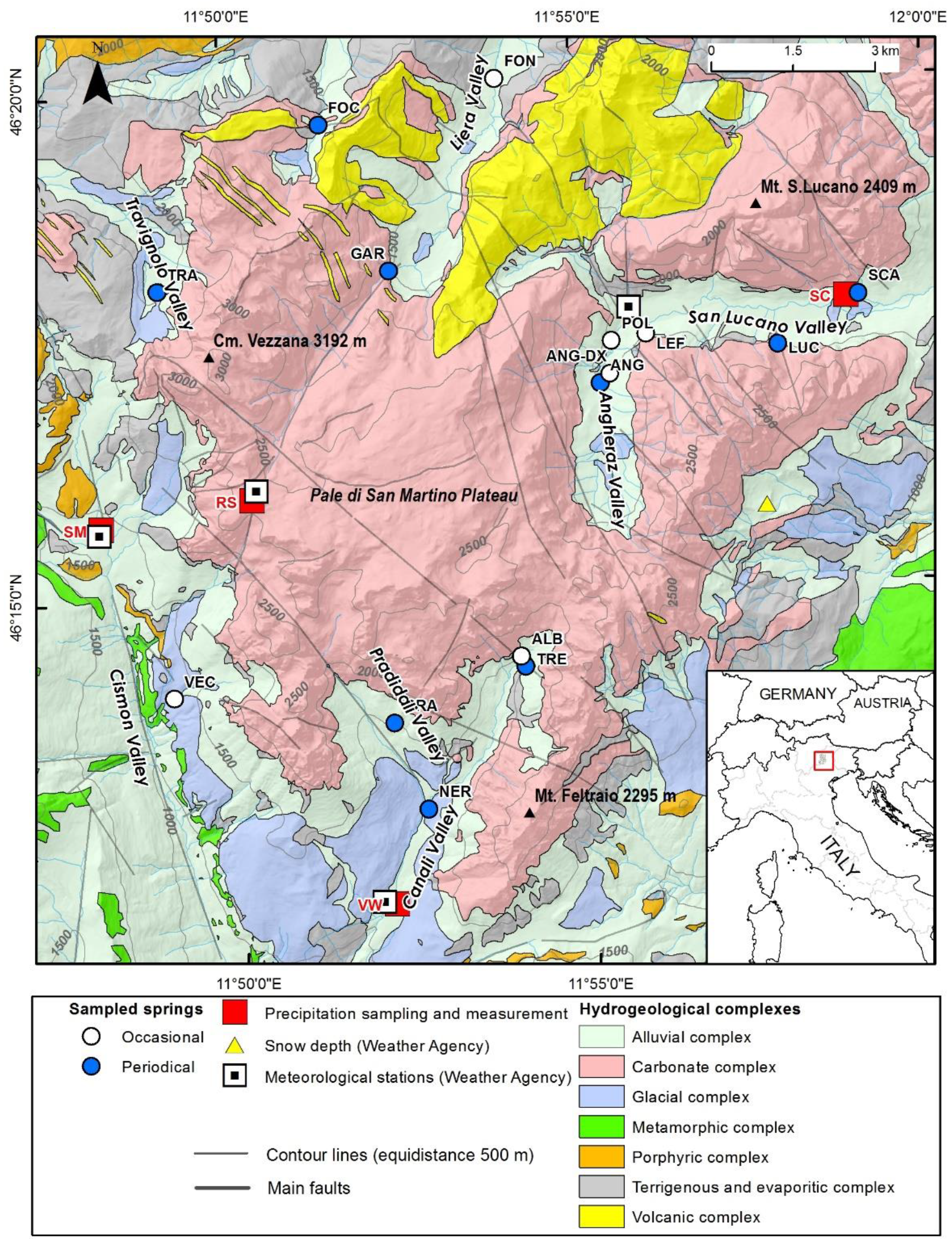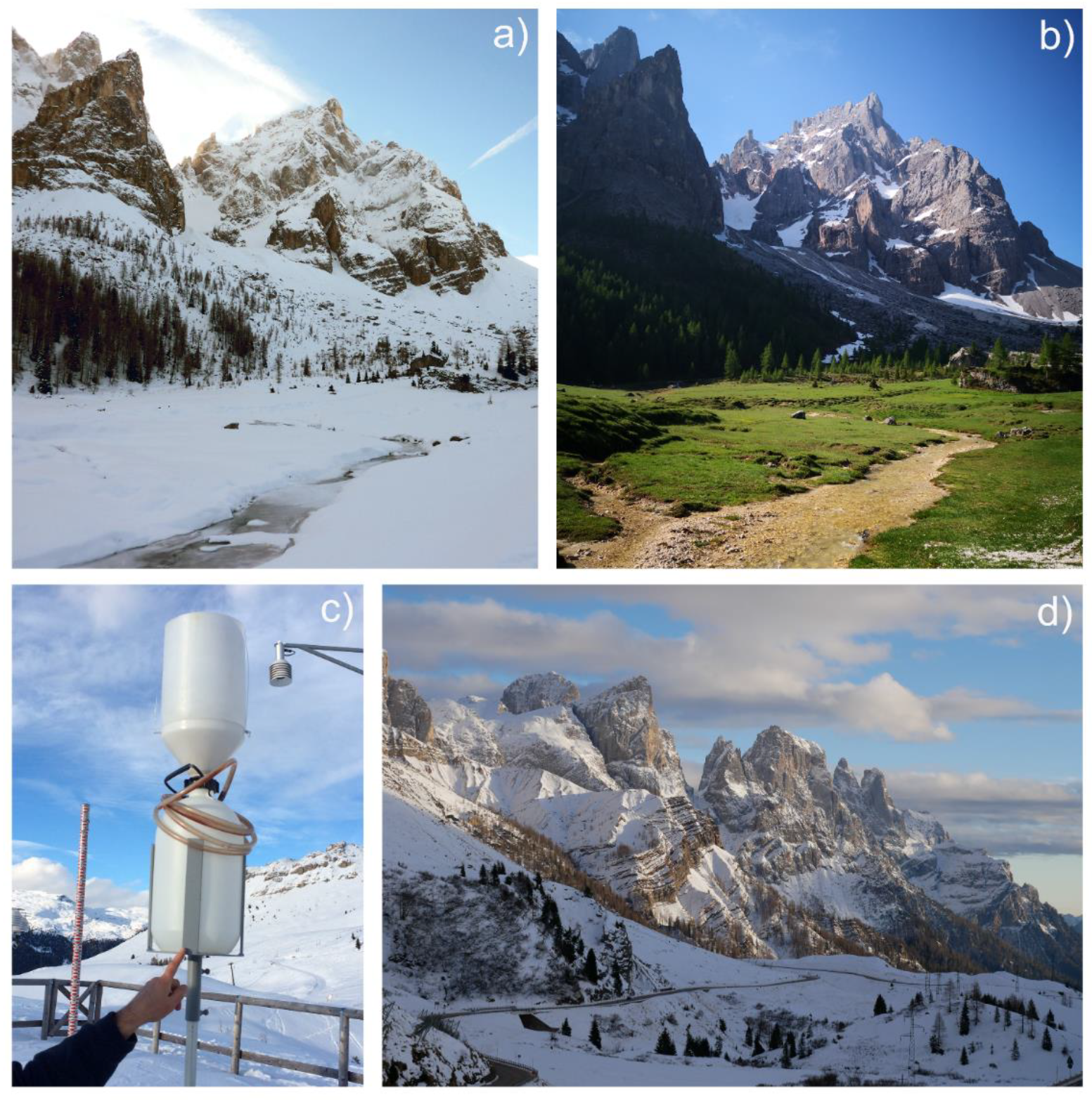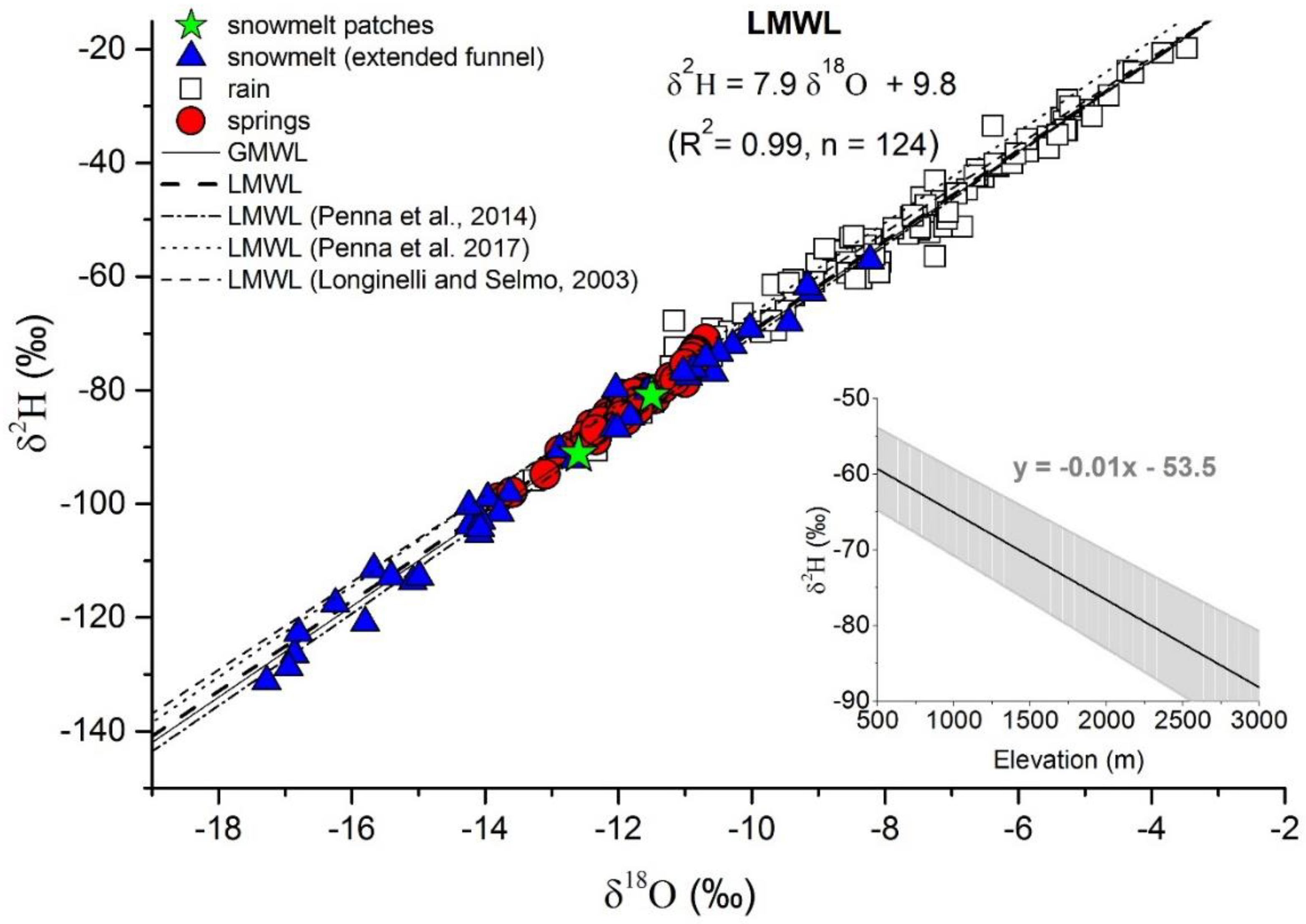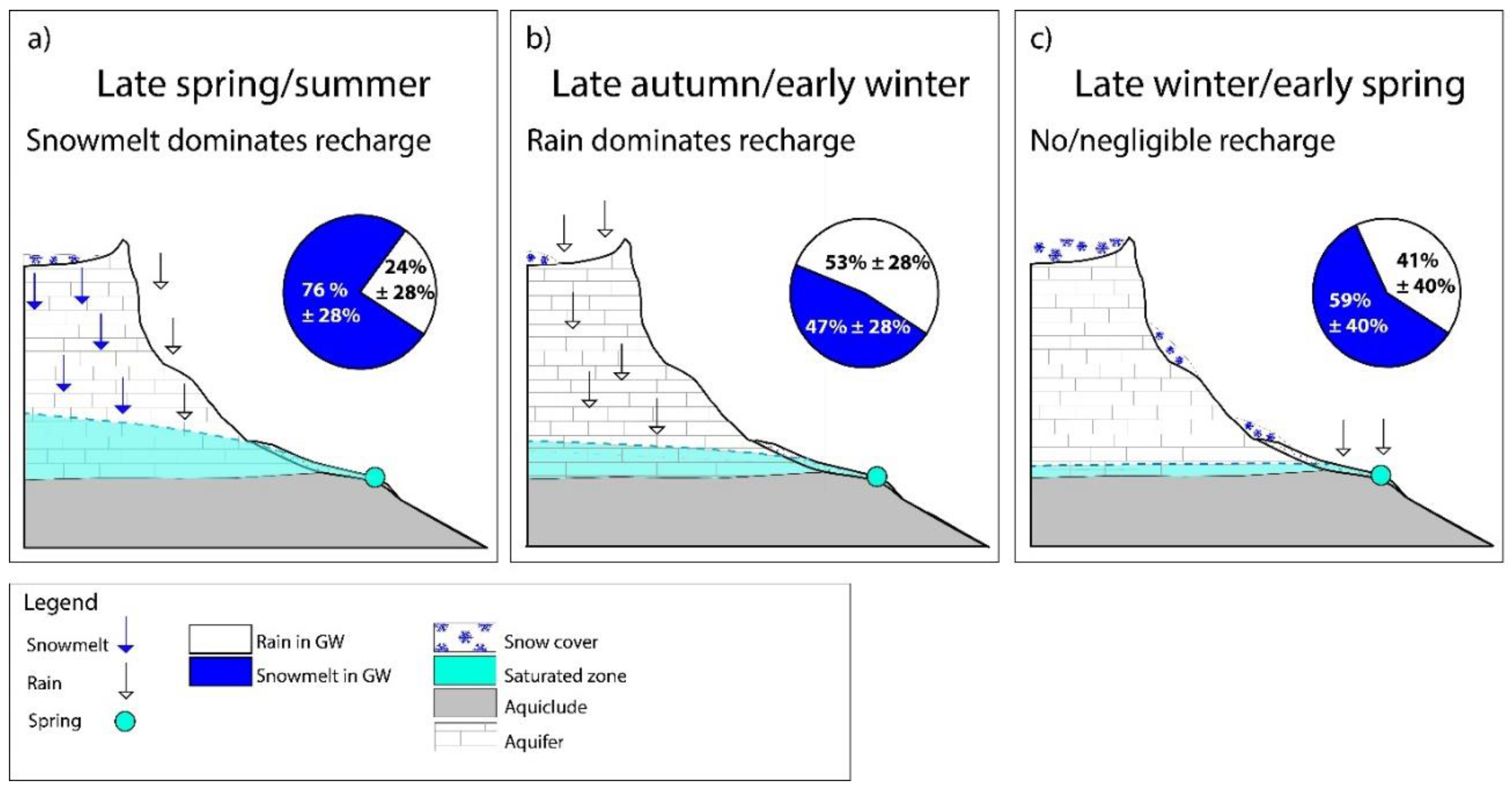The Role of Snowmelt on the Spatio-Temporal Variability of Spring Recharge in a Dolomitic Mountain Group, Italian Alps
Abstract
:1. Introduction
- What is the variability of the precipitation isotopic signal in the study area and how is this variability transferred to spring water?
- What is the fraction of snowmelt and rain in spring water and how does it change in space and time in this high-elevation mountain group?
- What can we infer on spring recharge dynamics in the study area?
2. Study Area
2.1. Geographical Setting
2.2. Hydrogeological Setting
3. Materials and Methods
3.1. Monitoring Network and Sampling
3.2. Laboratory Analysis
3.3. Climate and Spring Discharge Data
3.4. Data Analysis
3.4.1. Dual Isotope Analyses
3.4.2. Seasonal Variability of Spring Water Isotopic Composition
3.4.3. Two-Component Mixing Model
4. Results
4.1. Dual Isotope Analysis
4.2. Analysis of Seasonal and Spatial Variations of δ2H
4.3. Mixing Model Results
5. Discussion
5.1. Variability in the Isotopic Composition of Precipitation in the Study Site
5.2. Seasonal Variability of the Snowmelt Contribution to Spring Water
5.3. Spatial Variability of the Snowmelt Contribution to Spring Water
6. Conclusions
- Snowmelt and rain are both substantial sources of recharge to the springs in this Alpine Dolomitic mountain group. This contribution is seasonally variable and it is related to two main recharge periods: the first in late spring to summer during which recharge is mainly provided by snowmelt and the second one in late autumn to early winter dominated by rain recharge. Accordingly, during the monitoring period snowmelt fractions were high during mid-summer (on average 76 ± 28%) and low during the late autumn (on average 47 ± 28%). Extraordinary meteorological events were recorded in the monitoring period and resulted in an average snowmelt fraction in groundwater of 94 ± 9% after a 30-year record snowfall winter and in a rain contribution of approximately 70% (68 ± 17%) after an intense precipitation event (386.4 mm of rain in 48 h). A greater snowmelt fraction (59 ± 40%) compared to rain was calculated during baseflow conditions following an extraordinary dry period (64 days without precipitation), indicating the predominant role of snowmelt during periods of water scarcity.
- The snowmelt contribution in spring water is spatially variable throughout the mountain group according to the elevation of the spring recharge areas. High-altitude recharge areas, above 2500 m a.s.l., are characterized by a predominance of the snowmelt fraction over the rain contribution (72% ± 29%). A greater snowmelt contribution to spring recharge is observed also for recharge altitudes of approximately 2400 m a.s.l (65 ± 31%). Springs recharged below 2000 m a.s.l. are recharged mostly from rain (snowmelt fraction of 46 ± 26%).
- We argue that the relatively rapid transmission of the recharge pulses to the spring waters reflects a strong seasonal and climate-dependent character of the storage processes. Nevertheless, the attenuation of the isotopic variations compared to precipitation does not exclude the presence of a well-mixed groundwater component with longer residence times.
- Rain-dominated springs have a more stable isotopic composition compared to snow-dominated springs and this element may be considered when using seasonal variability statistical coefficients as residence time proxies.
Author Contributions
Funding
Acknowledgments
Conflicts of Interest
References
- Jansson, P.; Hock, R.; Schneider, T. The concept of glacier storage: A review. J. Hydrol. 2003, 282, 116–129. [Google Scholar] [CrossRef]
- Viviroli, D.; Dürr, H.H.; Messerli, B.; Meybeck, M.; Weingartner, R. Mountains of the world, water towers for humanity: Typology, mapping, and global significance. Water Resour. Res. 2007, 43. [Google Scholar] [CrossRef] [Green Version]
- Kirchner, J.W. Aggregation in environmental systems–Part 1: Seasonal tracer cycles quantify young water fractions, but not mean transit times, in spatially heterogeneous catchments. Hydrol. Earth Syst. Sci. 2016, 20, 279–297. [Google Scholar] [CrossRef] [Green Version]
- Notarnicola, C. Hotspots of snow cover changes in global mountain regions over 2000–2018. Remote. Sens. Environ. 2020, 243, 111781. [Google Scholar] [CrossRef]
- Beniston, M.; Keller, F.; Koffi, B.; Goyette, S. Estimates of snow accumulation and volume in the Swiss Alps under changing climatic conditions. Theor. Appl. Clim. 2003, 76, 125–140. [Google Scholar] [CrossRef] [Green Version]
- Marty, C.; Schlögl, S.; Bavay, M.; Lehning, M. How much can we save? Impact of different emission scenarios on future snow cover in the Alps. Cryosphere 2017, 11, 517–529. [Google Scholar] [CrossRef] [Green Version]
- Hoegh-Guldberg, O.; Jacob, D.; Taylor, M. Impacts of 1.5 °C Global Warming on Natural and Human Systems. In Global Warming of 1.5 °C. An IPCC Special Report on the Impacts of Global Warming of 1.5 °C Above Pre-Industrial Levels and Related Global Greenhouse Gas Emission Pathways, in the Context of Strengthening the Global Response to the Threat of Climate Change, Sustainable Development, and Efforts to Eradicate Poverty; Masson-Delmotte, V.P., Zhai, O.P., Pörtner, D., Roberts, J., Skea, P.R., Shukla, A., Pirani, W., Moufouma-Okia, C., Péan, R., Pidcock, S., et al., Eds.; Waterfield: San Francisco, CA, USA, 2018. [Google Scholar]
- Hanzer, F.; Förster, K.; Nemec, J.; Strasser, U. Projected cryospheric and hydrological impacts of 21st century climate change in the Ötztal Alps (Austria) simulated using a physically based approach. Hydrol. Earth Syst. Sci. 2018, 22, 1593–1614. [Google Scholar] [CrossRef] [Green Version]
- Kundzewicz, Z.W.; Mata, L.J.; Arnell, N.W.; Doell, P.; Jimenez-Cisneros, B.E.; Miller, K.; Oki, T.; Şen, Z.; Shiklomanov, I. The implications of projected climate change for freshwater resources and their management. Hydrol. Sci. J. 2008, 53, 3–10. [Google Scholar] [CrossRef]
- Chen, Z.; Hartmann, A.; Wagener, T.; Goldscheider, N. Dynamics of water fluxes and storages in an Alpine karst catchment under current and potential future climate conditions. Hydrol. Earth Syst. Sci. 2018, 22, 3807–3823. [Google Scholar] [CrossRef] [Green Version]
- Sevruk, B.; Kirchhofer, W. Mean annual corrections of measured precipitation depths 1951–1980. In Hydrological Atlas of Switzerland; Plate, 2; MeteoSwiss: Bern, Switzerland, 1992. [Google Scholar]
- Eccel, E.; Cau, P.; Ranzi, R. Data reconstruction and homogenization for reducing uncertainties in high-resolution climate analysis in Alpine regions. Theor. Appl. Clim. 2012, 110, 345–358. [Google Scholar] [CrossRef] [Green Version]
- De Jong, C. Challenges for mountain hydrology in the third millennium. Front. Environ. Sci. 2015, 3, 38. [Google Scholar] [CrossRef] [Green Version]
- Beria, H.; Larsen, J.R.; Ceperley, N.; Michelon, A.; Vennemann, T.; Schaefli, B. Understanding snow hydrological processes through the lens of stable water isotopes. Wiley Interdiscip. Rev. Water 2018, 5, e1311. [Google Scholar] [CrossRef] [Green Version]
- Penna, D.; Meerveld, H.J.; Zuecco, G.; Fontana, G.D.; Borga, M. Hydrological response of an Alpine catchment to rainfall and snowmelt events. J. Hydrol. 2016, 537, 382–397. [Google Scholar] [CrossRef]
- Penna, D.; Engel, M.; Mao, L.; Dell’agnese, A.; Bertoldi, G.; Comiti, F. Tracer-based analysis of spatial and temporal variations of water sources in a glacierized catchment. Hydrol. Earth Syst. Sci. 2014, 18, 5271–5288. [Google Scholar] [CrossRef] [Green Version]
- Lauber, U.; Goldscheider, N. Use of artificial and natural tracers to assess groundwater transit-time distribution and flow systems in a high-alpine karst system (Wetterstein Mountains, Germany). Hydrogeol. J. 2014, 22, 1807–1824. [Google Scholar] [CrossRef]
- Earman, S.; Campbell, A.R.; Phillips, F.M.; Newman, B.D. Isotopic exchange between snow and atmospheric water vapor: Estimation of the snowmelt component of groundwater recharge in the southwestern United States. J. Geophys. Res. Space Phys. 2006, 111. [Google Scholar] [CrossRef]
- Meng, Y.; Liu, G.; Li, M. Tracing the Sources and Processes of Groundwater in an Alpine Glacierized Region in Southwest China: Evidence from Environmental Isotopes. Water 2015, 7, 2673–2690. [Google Scholar] [CrossRef] [Green Version]
- Penna, D.; Zuecco, G.; Crema, S.; Trevisani, S.; Cavalli, M.; Pianezzola, L.; Marchi, L.; Borga, M. Response time and water origin in a steep nested catchment in the Italian Dolomites. Hydrol. Process. 2016, 31, 768–782. [Google Scholar] [CrossRef]
- Cooper, L.W. Isotopic Fractionation in Snow Cover. In Isotope Tracers in Catchment Hydrology; Elsevier: Amstesrdam, The Netherlands, 1998; pp. 119–136. [Google Scholar]
- Gat, J. Isotope Hydrology: A Study of the Water Cycle; World Scientific: Singapore, 2010; Volume 6. [Google Scholar]
- Moser, H.; Stichler, W. Deuterium and oxygen-18 contents as an index of the properties of snow covers. Int. Assoc. Hydro. Sci. 1974, 114, 122–135. [Google Scholar]
- Sokratov, S.; Golubev, V.N. Snow isotopic content change by sublimation. J. Glaciol. 2009, 55, 823–828. [Google Scholar] [CrossRef] [Green Version]
- Taylor, S.; Feng, X.; Kirchner, J.W.; Osterhuber, R.; Klaue, B.; Renshaw, C.E. Isotopic evolution of a seasonal snowpack and its melt. Water Resour. Res. 2001, 37, 759–769. [Google Scholar] [CrossRef] [Green Version]
- Lee, J.; Feng, X.; Faiia, A.M.; Posmentier, E.S.; Kirchner, J.W.; Osterhuber, R.; Taylor, S. Isotopic evolution of a seasonal snowcover and its melt by isotopic exchange between liquid water and ice. Chem. Geol. 2010, 270, 126–134. [Google Scholar] [CrossRef]
- Zhou, S.; Nakawo, M.; Hashimoto, S.; Sakai, A. The effect of refreezing on the isotopic composition of melting snowpack. Hydrol. Process. 2008, 22, 873–882. [Google Scholar] [CrossRef]
- Goldscheider, N. Fold structure and underground drainage pattern in the alpine karst system Hochifen-Gottesacker. Swiss J. Geosci. 2005, 98, 1–17. [Google Scholar] [CrossRef] [Green Version]
- Turk, J.; Malard, A.; Jeannin, P.-Y.; Petrič, M.; Gabrovšek, F.; Ravbar, N.; Vouillamoz, J.; Slabe, T.; Sordet, V. Hydrogeological characterization of groundwater storage and drainage in an alpine karst aquifer (the Kanin massif, Julian Alps). Hydrol. Process. 2014, 29, 1986–1998. [Google Scholar] [CrossRef]
- Filippini, M.; Squarzoni, G.; De Waele, J.; Fiorucci, A.; Vigna, B.; Grillo, B.; Riva, A.; Rossetti, S.; Zini, L.; Casagrande, G.; et al. Differentiated spring behavior under changing hydrological conditions in an alpine karst aquifer. J. Hydrol. 2018, 556, 572–584. [Google Scholar] [CrossRef]
- Guastini, E.; Zuecco, G.; Errico, A.; Castelli, G.; Bresci, E.; Preti, F.; Penna, D. How does streamflow response vary with spatial scale? Analysis of controls in three nested Alpine catchments. J. Hydrol. 2019, 570, 705–718. [Google Scholar] [CrossRef]
- Lucianetti, G.; Mazza, R.; Mastrorillo, L. Hydrogeology of a high Alpine carbonate aquifer (Pale di San Martino, Dolomites, Northern Italy). J. Maps 2019, 15, 448–459. [Google Scholar] [CrossRef] [Green Version]
- Bosellini, A. Geologia delle Dolomiti—Geology of the Dolomites; Bolzano: Atheisa, Italy, 1996. [Google Scholar]
- Doglioni, C. Tectonics of the Dolomites (southern alps, northern Italy). J. Struct. Geol. 1987, 9, 181–193. [Google Scholar] [CrossRef]
- Castellarin, A.; Cantelli, L.; Fesce, A.M.; Mercier, J.L.; Picotti, V.; Pini, G.A.; Prosser, G.; Selli, L. Alpine compressional tectonics in the Southern Alps. Relationships with the N-Apennines. Annales Tectonicae 1992, 6, 62–94. [Google Scholar]
- Bonat, M.; Lucianetti, G.; Mastrorillo, L.; Viaroli, S.; Mazza, R. The role of alpine valley fill deposits for groundwater storage (Dolomites, Italy). Grundwasser 2019, 25, 3–14. [Google Scholar] [CrossRef]
- Frisbee, M.D.; Phillips, F.M.; Campbell, A.R.; Hendrickx, J.M.H. Modified passive capillary samplers for collecting samples of snowmelt infiltration for stable isotope analysis in remote, seasonally inaccessible watersheds 1: Laboratory evaluation. Hydrol. Process. 2010, 24, 825–833. [Google Scholar] [CrossRef]
- Penna, D.; Ahmad, M.; Birks, S.J.; Bouchaou, L.; Brenčič, M.; Butt, S.; Holko, L.; Jeelani, G.; Martinez, D.E.; Melikadze, G.; et al. A new method of snowmelt sampling for water stable isotopes. Hydrol. Process. 2014, 28, 5637–5644. [Google Scholar] [CrossRef]
- Ala-Aho, P.; Tetzlaff, D.; McNamara, J.P.; Laudon, H.; Kormos, P.; Soulsby, C. Modeling the isotopic evolution of snowpack and snowmelt: Testing a spatially distributed parsimonious approach. Water Resour. Res. 2017, 53, 5813–5830. [Google Scholar] [CrossRef] [PubMed]
- Taylor, S.; Feng, X.; Williams, M.; McNamara, J. How isotopic fractionation of snowmelt affects hydrograph separation. Hydrol. Process. 2002, 16, 3683–3690. [Google Scholar] [CrossRef]
- Rücker, A.; Zappa, M.; Boss, S.; Von Freyberg, J. An Optimized Snowmelt Lysimeter System for Monitoring Melt Rates and Collecting Samples for Stable Water Isotope Analysis. J. Hydrol. Hydromech. 2019, 67, 20–31. [Google Scholar] [CrossRef] [Green Version]
- International Atomic Energy Agency (IAEA). Special Issue on the Global Network of Isotopes in Precipitation. In Water & Environment News; International Atomic Energy Agency: Vienna, Austria, 2002; Issue 16. [Google Scholar]
- Epstein, S.; Mayeda, T. Variation of O18 content of waters from natural sources. Geochim. Cosmochim. Acta 1953, 4, 213–224. [Google Scholar] [CrossRef]
- Metodologie di Misura e Specifiche Tecniche per la Raccolta e L’elaborazione dei Dati Idrometeorologici; Manuali e linee guida 60; Istituto Superiore per la Protezione e la Ricerca Ambientale (ISPRA): Rome, Italy, 2010; p. 159.
- Dansgaard, W. Stable isotopes in precipitation. Tellus 1964, 16, 436–468. [Google Scholar] [CrossRef]
- Kendall, C.; Coplen, T.B. Distribution of oxygen-18 and deuterium in river waters across the United States. Hydrol. Process. 2001, 15, 1363–1393. [Google Scholar] [CrossRef]
- Scholl, M.A.; Ingebritsen, S.E.; Janik, C.J.; Kauahikaua, J.P. Use of Precipitation and Groundwater Isotopes to Interpret Regional Hydrology on a Tropical Volcanic Island: Kilauea Volcano Area, Hawaii. Water Resour. Res. 1996, 32, 3525–3537. [Google Scholar] [CrossRef]
- Bansah, S.; Ali, G. Streamwater ages in nested, seasonally cold Canadian watersheds. Hydrol. Process. 2019, 33, 495–511. [Google Scholar] [CrossRef]
- Tetzlaff, D.; Seibert, J.; McGuire, K.J.; Laudon, H.; Burns, D.A.; Dunn, S.M.; Soulsby, C. How does landscape structure influence catchment transit time across different geomorphic provinces? Hydrol. Process. 2009, 23, 945–953. [Google Scholar] [CrossRef]
- Soulsby, C.; Birkel, C.; Geris, J.; Tetzlaff, D. The Isotope Hydrology of a Large River System Regulated for Hydropower. River Res. Appl. 2014, 31, 335–349. [Google Scholar] [CrossRef]
- James, A.L.; Dusome, E.; Field, T.; Yao, H.; McConnell, C.; Beaton, A.; Tafvizi, A. The isotope hydrology of the Muskoka River Watershed, Ontario, Canada. Hydrol. Process. 2019, 34, 914–926. [Google Scholar] [CrossRef]
- Pearce, A.J.; Stewart, M.K.; Sklash, M.G. Storm Runoff Generation in Humid Headwater Catchments: 1. Where Does the Water Come From? Water Resour. Res. 1986, 22, 1263–1271. [Google Scholar] [CrossRef]
- Engel, M.; Penna, D.; Bertoldi, G.; Dell’Agnese, A.; Soulsby, C.; Comiti, F. Identifying run-off contributions during melt-induced run-off events in a glacierized alpine catchment. Hydrol. Process. 2015, 30, 343–364. [Google Scholar] [CrossRef]
- Dingman, S.L. Physical Hydrology; Waveland Press: Long Grove, IL, USA, 2015. [Google Scholar]
- Penna, D.; Engel, M.; Bertoldi, G.; Comiti, F. Towards a tracer-based conceptualization of meltwater dynamics and streamflow response in a glacierized catchment. Hydrol. Earth Syst. Sci. 2017, 21, 23–41. [Google Scholar] [CrossRef] [Green Version]
- Genereux, D. Quantifying uncertainty in tracer-based hydrograph separations. Water Resour. Res. 1998, 34, 915–919. [Google Scholar] [CrossRef]
- Craig, H. Isotopic Variations in Meteoric Waters. Science 1961, 133, 1702–1703. [Google Scholar] [CrossRef]
- Longinelli, A.; Enricomaria, S. Isotopic composition of precipitation in Italy: A first overall map. J. Hydrol. 2003, 270, 75–88. [Google Scholar] [CrossRef]
- Flaim, G.; Camin, F.; Tonon, A.; Obertegger, U. Stable isotopes of lakes and precipitation along an altitudinal gradient in the Eastern Alps. Biogeochemistry 2013, 116, 187–198. [Google Scholar] [CrossRef]
- Jeelani, G.; Kumar, U.S.; Kumar, B. Variation of δ18O and δD in precipitation and stream waters across the Kashmir Himalaya (India) to distinguish and estimate the seasonal sources of stream flow. J. Hydrol. 2013, 481, 157–165. [Google Scholar] [CrossRef]
- Paternoster, M.; Liotta, M.; Favara, R. Stable isotope ratios in meteoric recharge and groundwater at Mt. Vulture volcano, southern Italy. J. Hydrol. 2008, 348, 87–97. [Google Scholar] [CrossRef]
- Coplen, T.B. Uses of environmental isotopes. In Regional Ground-Water Quality; Alley, W.B., Ed.; Van Nostrand Reinhold: New York, NY, USA, 1993; pp. 227–254. [Google Scholar]
- Schmieder, J.; Hanzer, F.; Marke, T.; Garvelmann, J.; Warscher, M.; Kunstmann, H.; Strasser, U. The importance of snowmelt spatiotemporal variability for isotope-based hydrograph separation in a high-elevation catchment. Hydrol. Earth Syst. Sci. 2016, 20, 5015–5033. [Google Scholar] [CrossRef] [Green Version]
- Schmieder, J.; Garvelmann, J.; Marke, T.; Strasser, U. Spatio-temporal tracer variability in the glacier melt end-member-How does it affect hydrograph separation results? Hydrol. Process. 2018, 32, 1828–1843. [Google Scholar] [CrossRef] [Green Version]
- Clark, I.D.; Fritz, P. Environmental Isotopes in Hydrogeology; Informa Limited: London, UK, 2013. [Google Scholar]
- Cochand, M.; Christe, P.; Ornstein, P.; Hunkeler, D. Groundwater Storage in High Alpine Catchments and Its Contribution to Streamflow. Water Resour. Res. 2019, 55, 2613–2630. [Google Scholar] [CrossRef] [Green Version]
- Cervi, F.; Borgatti, L.; Dreossi, G.; Marcato, G.; Michelini, M.; Stenni, B. Isotopic features of precipitation and groundwater from the Eastern Alps of Italy: Results from the Mt. Tinisa hydrogeological system. Environ. Earth Sci. 2017, 76, 410. [Google Scholar] [CrossRef]
- Froehlich, K.; Kralik, M.; Papesch, W.; Rank, D.; Scheifinger, H.; Stichler, W. Deuterium excess in precipitation of Alpine regions—moisture recycling. Isot. Environ. Health Stud. 2008, 44, 61–70. [Google Scholar] [CrossRef]
- Trček, B.; Zojer, H. Recharge of springs. In Groundwater Hydrology of Springs; Kresic, N., Stevanovic, Z., Eds.; Elsevier: Amsterdam, The Netherlands, 2010; pp. 87–127. [Google Scholar]
- Hood, J.L.; Hayashi, M. Characterization of snowmelt flux and groundwater storage in an alpine headwater basin. J. Hydrol. 2015, 521, 482–497. [Google Scholar] [CrossRef]
- Van Loon, A.F.; Van Lanen, H.A.J. A process-based typology of hydrological drought. Hydrol. Earth Syst. Sci. 2012, 16, 1915–1946. [Google Scholar] [CrossRef] [Green Version]
- Galleani, L.; Vigna, B.; Banzato, C.; Russo, S.L. Validation of a Vulnerability Estimator for Spring Protection Areas: The VESPA index. J. Hydrol. 2011, 396, 233–245. [Google Scholar] [CrossRef]
- Lucianetti, G.; Mastrorillo, L.; Mazza, R.; Partel, P. Groundwater response to precipitation extremes: The case of the “Vaia” storm (Eastern Italian Alps). Acque Sotter. Ital. J. Groundw. 2019. [Google Scholar] [CrossRef]
- Goldscheider, N.; Hotzl, H. Hydrological characteristics of folded alpine karst systems exemplified by the Gottesacker plateau (German–Austrian Alps). Acta. Carsologica 1999, 28, 87–103. [Google Scholar]
- Laghari, A.N.; Walasai, G.D.; Jatoi, A.R.; Bangwar, D.K.; Shaikh, A.H. Effects of Climate Change on Mountain Waters: A Case Study of European Alps. Eng. Technol. Appl. Sci. Res. 2018, 8, 3234–3237. [Google Scholar]
- Kobierska, F.; Jonas, T.; Magnusson, J.; Zappa, M.; Bavay, M.; Bosshard, T.; Paul, F.; Bernasconi, S.M. Climate change effects on snow melt and discharge of a partly glacierized watershed in Central Switzerland (SoilTrec Critical Zone Observatory). Appl. Geochem. 2011, 26, S60–S62. [Google Scholar] [CrossRef]
- Van Loon, A. Hydrological drought explained. Wiley Interdiscip. Rev. Water 2015, 2, 359–392. [Google Scholar] [CrossRef]
- Malcolm, I.A.; Soulsby, C.; Youngson, A.F.; Hannah, D.M.; McLaren, I.S.; Thorne, A. Hydrological influences on hyporheic water quality: Implications for salmon egg survival. Hydrol. Process. 2004, 18, 1543–1560. [Google Scholar] [CrossRef]









| Code | Name/Location | Elevation m a.s.l. | No. of Samples | Mean Discharge (L/s) | Sampling Period |
|---|---|---|---|---|---|
| Precipitation | |||||
| SC | Scalette | 725 | 35 | September 2014–December 2018 | |
| VW | Villa Welsperg | 1038 | 36 | September 2014–December 2018 | |
| SM | San Martino | 1470 | 33 | January 2015–December 2018 | |
| RS | Rosetta | 2660 | 20 | September 2014–September 2016 | |
| Snowmelt patches | Rosetta Plateau | 2650 | 2 | July 2014 and July 2016 | |
| Periodically monitored springs | |||||
| TRE | Treviso | 1580 | 8 | 30 | July 2014–December 2016 |
| NER | Acque nere springs | 1150 | 7 | 140 | December 2014–December 2016 |
| SCA | Scalette | 725 | 6 | 10 | July 2014–January 2016 |
| LUC | San Lucano | 900 | 6 | 130 | July 2014–January 2016 |
| ANG | Angheraz sx | 1018 | 9 | 350 | July 2014–December 2016 |
| PRA | Pradidali springs | 1456 | 8 | 210 | July 2014–December 2016 |
| TRA | Travignolo | 1960 | 8 | 50 | July 2014–December 2016 |
| FOC | Focobon | 1720 | 6 | 100 | July 2014–July 2016 |
| GAR | Gares | 1729 | 6 | 120 | July 2014–July 2016 |
| Occasionally monitored springs | |||||
| FON | Fontane Fosche | 1122 | 5 | 30 | December 2014–January 2016 |
| POL | Polver | 903 | 2 | 10 | January 2016–July 2016 |
| LEF | Le fontane | 935 | 1 | 80 | January 2016 |
| ANG-DX | Angheraz dx | 980 | 1 | 150 | January 2016 |
| VEC | Vecia | 1290 | 5 | 20 | December 2014–January 2016 |
| ALB | Alberghet | 1560 | 1 | 80 | July 2016 |
| Spring | Mean Recharge Elevation (m a.s.l.) |
|---|---|
| TRA | 2710 (2143–3391) |
| FOC | 2601 (2041–3273) |
| GAR | 2535 (1980–3202) |
| ANG | 2429 (1881–3087) |
| PRA | 2372 (1827–3025) |
| SCA | 1937 (1420–2553) |
| NER | 1856 (1345–2466) |
| LUC | 1853 (1342–2463) |
| TRE | 1782 (1276–2386) |
| Spring | Damping Ratio (DR) |
|---|---|
| TRA | 0.21 |
| FOC | 0.20 |
| GAR | 0.18 |
| LUC | 0.16 |
| SCA | 0.16 |
| PRA | 0.12 |
| TRE | 0.11 |
| ANG | 0.10 |
| NER | 0.09 |
| Date | Scenario 1 | Scenario 2 | ||||||
|---|---|---|---|---|---|---|---|---|
| Rain δ2H (‰) | Snowmelt δ2H (‰) | Rain δ2H (‰) | Snowmelt δ2H (‰) | |||||
| Weigh. avg. | SD | Weigh. avg. | SD | Weigh. avg. | SD | Weigh. avg. | SD | |
| 14 July | −54.9 | 16.4 | −91.2 | na | −55.1 | 15.5 | −91.2 | na |
| 14 December | −61.5 | 10.5 | −117.1 | 14.1 | −63.8 | 8.1 | −105.3 | 10.0 |
| 15 May | −60.6 | 11.6 | −102.4 | 16.8 | −64.5 | 6.7 | −102.5 | 18.5 |
| 15 July | −52.4 | 13.7 | −102.4 | 16.8 | −52.6 | 12.5 | −102.5 | 18.5 |
| 15 November | −55.5 | 13.9 | −98.0 | 17.2 | −57.2 | 12.6 | −94.8 | 18.8 |
| 16 January | −55.5 | 13.9 | −92.5 | 21.3 | −57.2 | 12.6 | −91.9 | 20.4 |
| 16 July | −56.8 | 13.4 | −89.3 | 19.6 | −57.5 | 12.3 | −88.2 | 18.4 |
| 16 December | −54.9 | 16.4 | −90.8 | 19.5 | −55.1 | 15.5 | −90.4 | 18.3 |
© 2020 by the authors. Licensee MDPI, Basel, Switzerland. This article is an open access article distributed under the terms and conditions of the Creative Commons Attribution (CC BY) license (http://creativecommons.org/licenses/by/4.0/).
Share and Cite
Lucianetti, G.; Penna, D.; Mastrorillo, L.; Mazza, R. The Role of Snowmelt on the Spatio-Temporal Variability of Spring Recharge in a Dolomitic Mountain Group, Italian Alps. Water 2020, 12, 2256. https://doi.org/10.3390/w12082256
Lucianetti G, Penna D, Mastrorillo L, Mazza R. The Role of Snowmelt on the Spatio-Temporal Variability of Spring Recharge in a Dolomitic Mountain Group, Italian Alps. Water. 2020; 12(8):2256. https://doi.org/10.3390/w12082256
Chicago/Turabian StyleLucianetti, Giorgia, Daniele Penna, Lucia Mastrorillo, and Roberto Mazza. 2020. "The Role of Snowmelt on the Spatio-Temporal Variability of Spring Recharge in a Dolomitic Mountain Group, Italian Alps" Water 12, no. 8: 2256. https://doi.org/10.3390/w12082256
APA StyleLucianetti, G., Penna, D., Mastrorillo, L., & Mazza, R. (2020). The Role of Snowmelt on the Spatio-Temporal Variability of Spring Recharge in a Dolomitic Mountain Group, Italian Alps. Water, 12(8), 2256. https://doi.org/10.3390/w12082256






